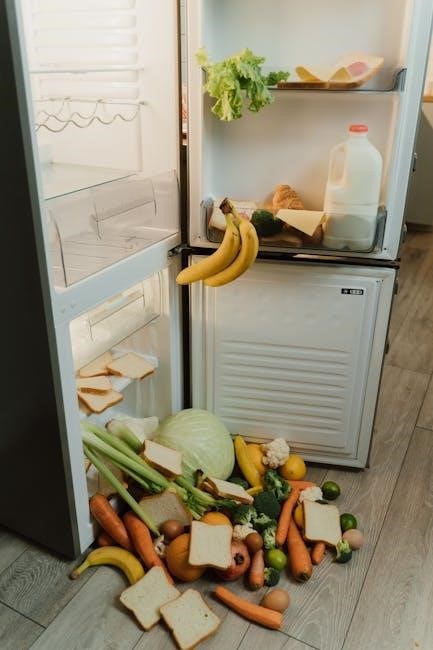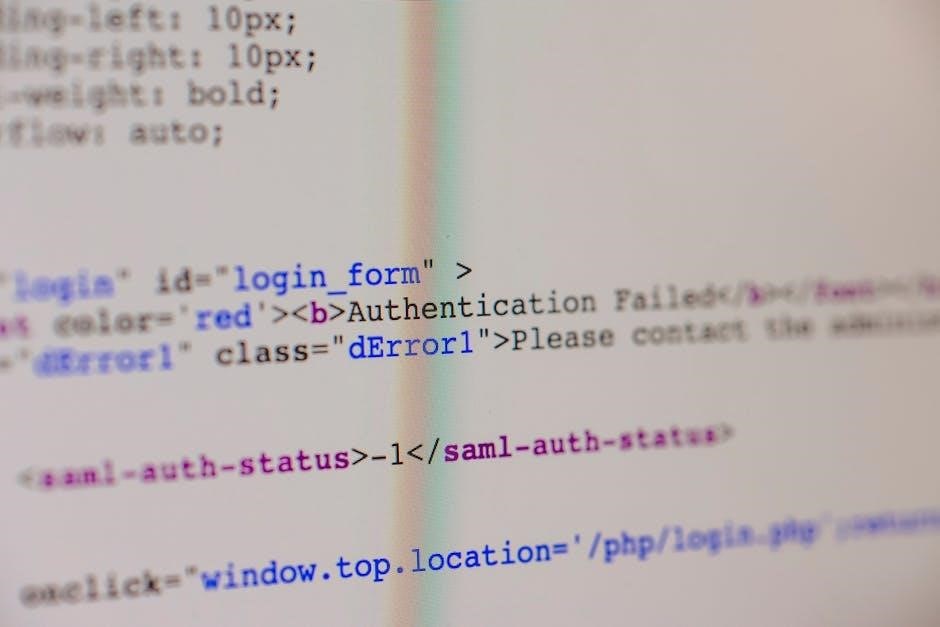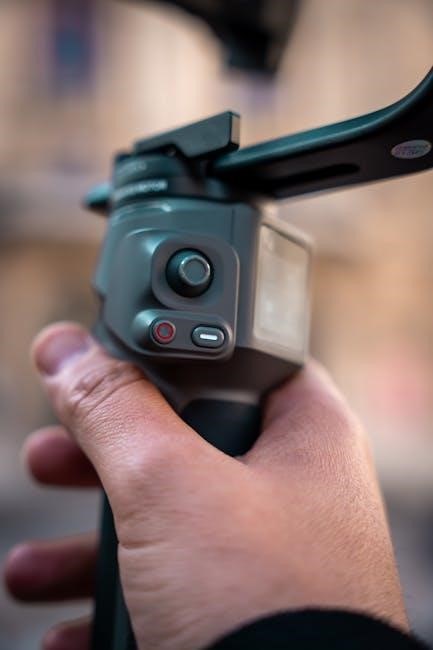Welcome to the GE Refrigerator Error Codes Manual, your comprehensive guide to understanding and resolving issues with your appliance. This manual provides detailed explanations of error codes, their meanings, and troubleshooting steps to help you maintain optimal performance and address malfunctions efficiently. Whether you’re dealing with routine maintenance or unexpected errors, this manual is your go-to resource for keeping your GE refrigerator running smoothly.
Overview of GE Refrigerator Error Codes
GE refrigerator error codes serve as vital indicators to help users identify and resolve potential issues efficiently. Each code signifies a specific problem, ranging from simple fixes like power failures to more intricate malfunctions such as sensor errors. The manual provides an extensive list of these codes, detailing their meanings and offering step-by-step solutions. By understanding and addressing these codes, users can troubleshoot effectively, minimize downtime, and ensure optimal performance. This comprehensive guide is a valuable resource for maintaining your GE refrigerator and prolonging its lifespan.
Importance of Understanding Error Codes
Understanding GE refrigerator error codes is crucial for maintaining appliance performance and preventing potential damage. These codes act as early warning systems, signaling issues before they escalate into more serious problems. By recognizing and addressing error codes promptly, users can avoid costly repairs, reduce downtime, and ensure the longevity of their refrigerator. Additionally, understanding error codes empowers users to troubleshoot minor issues independently, saving time and money. This knowledge also helps maintain optimal food safety and energy efficiency, ensuring the appliance operates at its best. Familiarizing yourself with error codes is a proactive step toward responsible appliance ownership and trouble-free operation.
How to Use the Error Codes Manual Effectively
To use the GE Refrigerator Error Codes Manual effectively, start by identifying the specific error code displayed on your appliance. Refer to the manual to understand the code’s meaning and the corresponding issue. Next, follow the step-by-step troubleshooting guide to diagnose and address the problem. Always prioritize safety by unplugging the refrigerator before attempting repairs. For complex issues, consult the technical data sheets or contact a professional. Regularly review the manual to familiarize yourself with common error codes and preventive maintenance tips. This proactive approach ensures efficient resolution of issues, minimizing downtime and extending your appliance’s lifespan. By following these steps, you can maximize the manual’s benefits and keep your refrigerator operating smoothly.

Common GE Refrigerator Error Codes and Their Meanings
This section outlines the most common GE refrigerator error codes, explaining each code’s meaning and significance to help users identify and address issues effectively.
FF Error Code: Freezer Fan Failure
The FF error code indicates a freezer fan failure in your GE refrigerator. This occurs when the freezer evaporator fan motor stops working, causing rising temperatures. Check for obstructions or damage to the fan. Ensure proper airflow by clearing debris and verifying fan operation. If the fan is damaged, replace it to restore functionality. Addressing this issue promptly prevents thawing of frozen items and maintains optimal performance. Regular maintenance can help avoid such errors. Always refer to your manual for specific instructions or contact a professional if needed. Keep your freezer running efficiently by resolving this issue quickly.
PF Error Code: Power Failure
The PF error code on your GE refrigerator indicates a power failure. This occurs when the appliance experiences an interruption in its power supply. Check that the refrigerator is properly plugged into a functioning outlet and that no circuit breakers or fuses have tripped. Ensure the power cord is undamaged and securely connected. If the issue persists, perform a hard reset by unplugging the refrigerator for five minutes and then plugging it back in. This can sometimes resolve the error. If the problem continues, it may indicate a more serious electrical issue, and you should contact a professional technician for assistance. Regular checks can help prevent future power-related errors.
CI Error Code: Check Ice Maker
The CI error code on your GE refrigerator indicates an issue with the ice maker. This code typically appears when the ice maker is turned off, jammed, or malfunctioning. First, check if the ice maker switch is in the “on” position. If the issue persists, inspect the ice maker for blockages or frozen ice. Ensure the water supply to the ice maker is functioning properly and not restricted. If the problem continues, it may indicate a faulty ice maker motor, sensor, or electrical connection. In such cases, resetting the ice maker or replacing damaged components may be necessary. Regular maintenance, such as cleaning the ice maker and ensuring proper water flow, can help prevent this error from occurring.
DE Error Code: Demo Mode
The DE error code on your GE refrigerator signifies that the appliance is in Demo Mode. This mode is typically activated during in-store displays to reduce energy consumption and noise. While in Demo Mode, the refrigerator’s cooling functions are disabled, and the doors may not seal properly. To exit Demo Mode, locate the control panel and press and hold the appropriate buttons as per your user manual—usually the “Settings” or “Mode” buttons. Once Demo Mode is deactivated, the refrigerator will resume normal operation, ensuring proper cooling and functionality. If you encounter difficulties, consulting the user manual or contacting GE support is recommended to resolve the issue efficiently. Regular checks can prevent accidental activation, ensuring uninterrupted performance.
DF Error Code: Defrost Error
The DF error code on your GE refrigerator indicates a defrost-related issue. This occurs when the appliance detects a problem in the defrost system, such as a faulty defrost sensor, a failed defrost heater, or a malfunction in the defrost timer. When this error is displayed, the defrost cycle may not operate correctly, potentially leading to excessive ice buildup in the freezer compartment. To address this, check for blockages in the evaporator coils or ensure proper air circulation. If the issue persists, it may be necessary to inspect and replace faulty components or contact a professional for assistance. Regular maintenance, such as cleaning the condenser coils, can help prevent defrost-related errors from occurring in the future.
E0 Error Code: Communication Error
The E0 error code on your GE refrigerator indicates a communication error between the control boards. This issue typically occurs when there is a disruption in the communication between the main control board and the user interface or other components. Common causes include loose wiring connections, faulty communication cables, or a malfunctioning control board. To resolve this, check all wiring connections for tightness and inspect for any signs of damage or corrosion. If the issue persists, it may be necessary to replace the faulty control board or consult a professional for further diagnosis. Regular maintenance, such as ensuring proper connections and updating software, can help prevent communication errors from occurring in the future.
E1 Error Code: Thermistor Error
The E1 error code on your GE refrigerator indicates a thermistor error, which occurs when the appliance detects an issue with the temperature sensor. The thermistor is responsible for monitoring internal temperatures and relaying data to the control board. A faulty thermistor or poor wiring connections can trigger this error. To resolve this, inspect the thermistor for any visible damage or corrosion and ensure all wiring connections are secure. If the thermistor is damaged, it may need to be replaced. In some cases, the control board may also require attention. Addressing this issue promptly is crucial to maintain proper temperature regulation and prevent food spoilage. Always refer to your manual for specific instructions or consult a professional if needed.
E2 Error Code: Temperature Sensor Error
The E2 error code indicates a temperature sensor error in your GE refrigerator. This occurs when the control board detects an issue with the temperature sensor, which is crucial for monitoring and maintaining the correct internal temperatures. A faulty sensor or loose connections can cause this error, leading to improper cooling or inconsistent temperature levels. To resolve this, inspect the temperature sensor and its wiring for any damage or corrosion. Ensure all connections are secure and properly aligned. If the sensor is damaged, it may need to be replaced. Additionally, check the control board for any signs of malfunction, as it could also contribute to this error. Addressing this issue promptly is essential to restore normal operation and prevent food spoilage.
E3 Error Code: Defrost Sensor Error
The E3 error code indicates a defrost sensor error in your GE refrigerator. This sensor monitors temperatures during the defrost cycle to ensure proper operation. If the sensor fails or its wiring is compromised, the E3 code appears. A faulty defrost sensor can disrupt the defrost cycle, leading to excessive ice buildup or improper cooling. To resolve this, inspect the defrost sensor and its connections for damage or corrosion. Ensure the sensor is properly aligned and functioning. If damaged, replace the sensor or faulty component. Additionally, check the control board for any issues, as it may contribute to the error. Addressing this promptly prevents further damage and maintains efficient appliance performance.
5Y EF Error Code: Evaporator Fan Motor Issue
The 5Y EF error code signals an issue with the evaporator fan motor or its connection to the control board. This motor is essential for circulating air in the freezer compartment. If the motor fails or its wiring is damaged, the error appears. Check the fan motor for proper operation and inspect the wiring between the motor and the control board for any signs of damage or disconnection. Ensure all connections are secure. If the motor is defective, it may need replacement. Additionally, verify the control board’s functionality, as it can cause communication issues with the fan motor. Addressing this error promptly prevents temperature fluctuations and maintains efficient cooling performance in your GE refrigerator.
ER3 Error Code: Evaporator Probe Alarm
The ER3 error code indicates an issue with the evaporator probe, which monitors temperature in the freezer compartment. A defective probe triggers the evaporator probe alarm, activating the buzzer and displaying the ER3 code. This error occurs when the probe fails to function correctly or loses connection. Check the probe for damage or blockages and ensure all wiring connections are secure. If the probe is faulty, it may need replacement. Additionally, inspect the wiring between the probe and the control board for any damage or corrosion. Addressing the ER3 error promptly is crucial to maintain proper temperature regulation and prevent food spoilage. Regular maintenance of the probe and associated components can help avoid this issue in the future.

Troubleshooting Guide for GE Refrigerator Error Codes

This guide provides step-by-step solutions for resolving error codes. Learn to identify codes, clear them, and address common issues like power failures or sensor malfunctions. Check components and follow maintenance tips to prevent future errors and ensure smooth operation.
How to Identify the Error Code on the Display
To identify the error code on your GE refrigerator’s display, start by locating the control panel, usually found on the front or top of the unit. Error codes typically appear as a combination of letters and numbers and may flash repeatedly to grab your attention. Common codes include FF for freezer fan failure and PF for power failure. Refer to the provided manual or online resources to decode the specific code displayed. Activate the error code display by pressing and holding the temperature adjustment buttons for a few seconds. Once the code is visible, consult the manual or a trusted online source for explanations and troubleshooting steps. This process ensures you accurately diagnose and address the issue, whether it’s a simple reset or a more complex repair requiring professional assistance. Regular checks and maintenance can help prevent future errors, keeping your refrigerator functioning optimally.
Steps to Clear the Error Code
To clear an error code on your GE refrigerator, start by pressing the System Check button, usually located on the control panel, to reset the display. If the code persists, unplug the refrigerator from the power outlet for at least five minutes to perform a hard reset. Once plugged back in, check if the error code has disappeared. For some models, pressing and holding the temperature adjustment buttons simultaneously for a few seconds can also reset the system. If the error code reappears, it indicates a recurring issue that may require professional attention. Always ensure the power cord is securely connected and the refrigerator is properly ventilated to prevent future errors. Regular maintenance can help avoid such issues altogether.
Troubleshooting Power-Related Issues
Power-related issues are common in GE refrigerators, often indicated by error codes like PF (Power Failure). To address these, first, ensure the power cord is securely connected to both the refrigerator and the wall outlet. Check the circuit breaker or fuse box to confirm the power supply is stable. If the issue persists, unplug the refrigerator, wait five minutes, and plug it back in to reset the system. This hard reset often resolves temporary glitches. Additionally, avoid using extension cords or power strips, as they can disrupt the power supply. If the error code reappears, contact a licensed electrician to inspect the electrical connections or a GE service professional for further assistance. Always prioritize safety when handling electrical components.
Resolving Temperature Sensor Problems
Temperature sensor errors, such as E1, E2, or E3, indicate issues with thermistor or sensor functionality. Start by checking the sensor for physical damage or blockages. Ensure proper placement and cleanliness, as debris can disrupt readings. If the sensor is faulty, it may need replacement. Verify wiring connections between the sensor and control board for any signs of damage or corrosion. If issues persist, refer to the technical data sheet in the mini-manual for specific instructions. Regularly cleaning condenser coils and maintaining proper door seals can also help prevent temperature-related errors. Addressing these problems promptly ensures consistent cooling and prevents food spoilage. Always follow safety guidelines when handling electrical components, and consult a professional if unsure.
Fixing Defrost-Related Errors
Defrost-related errors, such as DF or E3, indicate issues with the defrost system. Start by checking the defrost sensor for proper function and ensuring it’s free from ice buildup. Verify the defrost drain for blockages, as clogs can prevent proper water flow. Inspect the defrost heater and thermostat for damage or malfunction. If the error persists, check the wiring connections between components. Power-related issues, such as interrupted electricity, can also trigger defrost errors. Refer to the technical data sheet in the mini-manual for specific diagnostic steps. Regular maintenance, like cleaning condenser coils and ensuring door seals are tight, can help prevent defrost-related problems. Addressing these issues promptly is crucial to maintain efficient cooling and prevent damage to the appliance.
Checking and Replacing Faulty Components
When addressing error codes, identifying and replacing faulty components is essential. Start by locating the error code in the manual to determine the affected part. For example, FF indicates a freezer fan issue, while E0 points to communication problems. Inspect the component for visible damage or wear. Check wiring connections and ensure proper functionality. If a sensor or motor is faulty, replace it with a genuine GE part. Refer to the mini-manual for specific instructions and diagrams. Regularly cleaning condenser coils and ensuring door seals are tight can prevent many issues. Always follow safety guidelines when handling electrical components, and consult a professional if unsure. Replacing faulty parts promptly ensures optimal performance and prevents further damage.

Maintenance Tips to Prevent Error Codes

- Regular Cleaning: Clean condenser coils to ensure efficient cooling and prevent errors.
- Check Door Seals: Ensure proper sealing to maintain temperature and avoid system strain.
- Maintain Temperature Settings: Keep settings within recommended ranges to prevent overloading the system.
- Schedule Maintenance: Regular professional checks can identify and fix issues before they cause errors.
Regular Cleaning of the Condenser Coils
Regular cleaning of the condenser coils is essential for maintaining your GE refrigerator’s efficiency and preventing error codes. Dirty coils can cause the appliance to work harder, leading to increased energy consumption and potential malfunctions. To clean the coils, start by turning off the power to the refrigerator. Locate the condenser coils, usually found at the back or bottom of the unit. Use a vacuum cleaner or a soft brush to gently remove dust and debris. Ensure all vents and grilles are unobstructed to allow proper air circulation. Cleaning the coils every 6 to 12 months can significantly reduce the risk of error codes like FF or PF. This simple maintenance step helps maintain optimal performance and extends the lifespan of your refrigerator.
Checking Door Seals for Proper Function
Ensuring proper function of your GE refrigerator’s door seals is crucial for maintaining consistent temperatures and preventing error codes. Start by visually inspecting the seals for signs of wear, cracks, or dirt buildup. Perform the “dollar bill test”: place a dollar bill between the door and the refrigerator, then close the door. If the bill slides out easily, the seal may be compromised. Clean the seals regularly with a mild soap solution to remove dirt and moisture. If the seals are damaged, replace them immediately to avoid issues like temperature fluctuations, which can trigger error codes such as CI or E2. Properly functioning door seals are essential for efficient operation and error prevention.

Maintaining Proper Temperature Settings
Maintaining proper temperature settings in your GE refrigerator is essential for optimal performance and preventing error codes. Ensure the refrigerator compartment is set between 37°F and 40°F, while the freezer should be at or below 0°F. Incorrect settings can lead to issues like temperature fluctuations, which may trigger error codes such as E2 or CI. Regularly check the temperature display and adjust as needed. Avoid excessive opening of doors, as this can disrupt internal temperatures. Additionally, overcrowding the shelves can hinder proper air circulation, affecting temperature distribution. Proper temperature maintenance not only prevents errors but also ensures food freshness and energy efficiency. Regular checks can help identify and address potential issues early.
Scheduling Professional Maintenance
Scheduling professional maintenance for your GE refrigerator is crucial for its longevity and optimal performance. Experts recommend annual check-ups to inspect critical components like condenser coils, door seals, and temperature sensors. During these visits, technicians ensure proper function and address potential issues before they escalate. Regular maintenance helps prevent error codes related to temperature fluctuations, defrost malfunctions, and sensor inaccuracies. Additionally, professional maintenance ensures compliance with warranty requirements and enhances energy efficiency. By staying proactive, you can avoid unexpected breakdowns and maintain your refrigerator’s reliability. Always refer to your user manual for specific maintenance recommendations tailored to your model.

GE Refrigerator Error Codes and User Manual
Your GE refrigerator’s mini-manual, located under the hinge cover, contains essential error code information and troubleshooting guides. Refer to it for quick solutions and detailed technical data sheets to address issues efficiently. Keeping the manual handy ensures you can resolve problems promptly, understand error meanings, and perform routine maintenance effectively. This resource is vital for maintaining your appliance’s performance and extending its lifespan. Always consult the manual before attempting repairs to ensure safety and proper procedures are followed. It’s your key to understanding and managing your GE refrigerator’s error codes successfully.
Location of the Mini-Manual in the Refrigerator
The mini-manual for your GE refrigerator is conveniently located under the hinge cover, providing easy access to essential information. Inside, you’ll find a complete list of error codes, technical data sheets, and troubleshooting guides. This manual is designed to help you quickly identify and resolve issues, ensuring your appliance runs smoothly. Regularly reviewing the mini-manual can help you understand error meanings and perform routine maintenance effectively. It’s a valuable resource for addressing common problems like power failures, sensor issues, and defrost errors. Keep the manual in a safe place for future reference, as it contains critical information for maintaining your refrigerator’s performance and extending its lifespan.
Understanding Technical Data Sheets
Technical data sheets within the GE refrigerator manual provide detailed specifications and operational parameters for your appliance. These sheets outline error codes, their definitions, and corresponding troubleshooting steps. They also include schematics and diagrams to help identify components and understand their functions. By referencing these sheets, you can gain insights into your refrigerator’s internal systems, such as temperature sensors, defrost mechanisms, and communication modules. This information is crucial for diagnosing issues like thermistor errors or evaporator fan problems. Regularly reviewing the technical data sheets ensures you’re well-prepared to address malfunctions and maintain your refrigerator’s performance. They serve as a bridge between user-friendly guides and advanced repair instructions, making them indispensable for both routine maintenance and complex repairs.
Importance of Keeping the Manual for Future Reference

Keeping the GE refrigerator error codes manual is essential for quick reference and troubleshooting. It provides detailed explanations of error codes, their causes, and solutions, ensuring you can address issues promptly. The manual also includes technical specifications, diagrams, and maintenance tips to help you understand your appliance better. Over time, you may encounter various error codes, and having the manual readily available saves time and reduces frustration. It also serves as a valuable resource for future owners or technicians. Regularly reviewing the manual helps you stay informed about optimal maintenance practices and prevents potential problems. By keeping it safe, you ensure long-term efficiency and reliability of your GE refrigerator.
This manual provides a comprehensive guide to understanding and addressing GE refrigerator error codes, ensuring optimal performance and quick troubleshooting for years to come.
This manual serves as a comprehensive resource for understanding and addressing GE refrigerator error codes. It covers common codes like FF, PF, CI, DE, DF, E0, E1, E2, E3, 5Y EF, and ER3, explaining their causes and solutions. Troubleshooting guides provide step-by-step instructions for resolving issues, from identifying error codes to clearing them and fixing components. Maintenance tips, such as cleaning condenser coils and checking door seals, help prevent future errors. The manual also emphasizes the importance of referencing the mini-manual and technical data sheets for detailed information. By following this guide, users can ensure their GE refrigerator operates efficiently and prolong its lifespan. Regular maintenance and prompt error resolution are key to avoiding costly repairs and maintaining optimal performance.
Final Tips for Managing Refrigerator Error Codes

To effectively manage GE refrigerator error codes, always start by identifying the specific code and its meaning using the manual or online resources. Perform a hard reset by unplugging the fridge for 5 minutes to clear temporary glitches. Regularly inspect and clean condenser coils, check door seals, and ensure proper temperature settings to prevent errors. If issues persist, consult the mini-manual or technical data sheets for detailed guidance. Address defrost and sensor-related errors promptly to avoid further complications. For complex problems, contact a certified technician to avoid damaging the appliance. Keep this manual handy for quick reference and remember, proactive maintenance is key to minimizing error occurrences and ensuring long-term efficiency.



